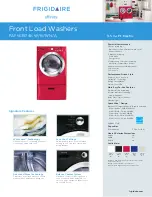
Energy and water consumption
– Water consumption and energy
usage are determined by the size of
the load.
To make the most out of your
machine, load the maximum dry load
for the programme you are using.
– When smaller amounts of laundry are
washed, the automatic load
recognition system will reduce the
amount of water, time and energy
used. This may mean that the time
left shown in the display is adjusted
during the course of the wash
programme.
– Use the
Express 20
programme for
small loads.
– Modern detergents enable washing
at reduced temperatures (e.g.
20°C
).
Use appropriate temperature
settings for saving energy.
– To maintain hygienic conditions in
the washing machine, it is
recommended that you occasionally
run a wash with a temperature of at
least 60°C. The
Hygiene Info
message in the display reminds you
to do this.
– Using the
Cottons Eco 40°C
programme is recommended for a
normally soiled load and is the
programme used in energy/water
consumption tests in accordance
with AS/NZS 2040 (refer to
Consumption data).
Detergent consumption
– Do not exceed the amounts of
detergent recommended by the
manufacturer on the packaging.
– Adjust the dosage to the degree of
soiling of the laundry.
– Use the automatic detergent
dispensing unit for the precise
dosage.
Choosing the correct Extra (Short,
Soak, Pre-wash)
Select:
– A wash programme together with the
Short
Extra option for light to normal
soiling where there are no obvious
marks.
– A wash programme without any
Extras for normal to heavy soiling
with visible staining.
– A wash programme together with the
Soak
Extra option for heavily soiled
laundry.
– The
Pre-wash
Extra option for
laundry with large amounts of dirt
(e.g. dust, sand).
When drying with a tumble dryer
Selecting the highest possible spin
speed for the wash programme will
save energy when drying in a tumble
dryer afterwards.
Washing environmentally and economically
27
















































